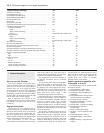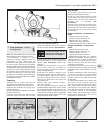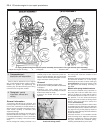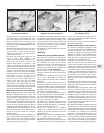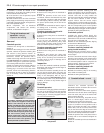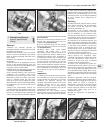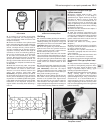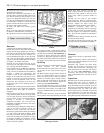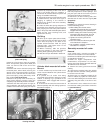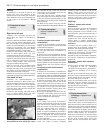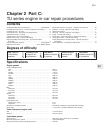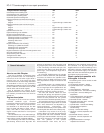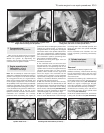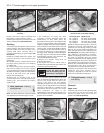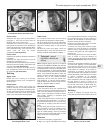
39 Check the valve clearances and adjust, if
necessary (see Section 2).
40 Refit the remaining components in the
reverse order of removal and with reference to
the relevant Sections and Chapters of this
manual as applicable. Make sure that the
correct inlet manifold gasket is fitted. A gasket
for carburettor versions is included in the
gasket overhaul set which is not the same as
the one for fuel injection models.
41 Refill and bleed the cooling system
(Chapter 1).
42 If a new timing belt has been fitted, refer
to Section 4 and retension it if necessary.
43 Tighten the engine mounting bracket bolt.
9 Sump - removal and refitting
3
Removal
1 Disconnect the battery negative lead.
2 Drain the engine oil, then clean and refit the
engine oil drain plug, tightening it securely. If
the engine is nearing its service interval when
the oil and filter are due for renewal, it is
recommended that the filter is also removed,
and a new one fitted. After reassembly, the
engine can then be refilled with fresh oil. Refer
to Chapter 1 for further information.
3 Chock the rear wheels then jack up the
front of the car and support it on axle stands
(see “Jacking and vehicle support”).
4 On models with air conditioning, where the
compressor is mounted onto the side of the
sump, remove the drivebelt as described in
Chapter 1. Unbolt the compressor, and
position it clear of the sump. Support the
weight of the compressor by tying it to the
vehicle, to prevent any excess strain being
placed on the compressor lines. Do not
disconnect the refrigerant lines from the
compressor (refer to the warnings given in
Chapter 3).
5 Disconnect the wiring to the oil level sensor
and the hose to the crankcase ventilation
system suction drain pipe on models so
equipped.
6 Progressively slacken and remove all the
sump retaining bolts. Since the sump bolts
vary in length and type, remove each bolt in
turn, and store it in its correct fitted order by
pushing it through a clearly-marked
cardboard template. This will avoid the
possibility of installing the bolts in the wrong
locations on refitting.
7 Break the joint by striking the sump with the
palm of your hand. Lower the sump, and
withdraw it from underneath the vehicle.
Remove the gasket (where fitted), and discard
it; a new one must be used on refitting. While
the sump is removed, take the opportunity to
check the oil pump pick-up/strainer for signs
of clogging or splitting. If necessary, remove
the pump as described in Section 10, and
clean or renew the strainer.
8 On some models, a large spacer plate is
fitted between the sump and the base of the
cylinder block/crankcase (see illustration). If
this plate is fitted, undo the two retaining
screws from diagonally-opposite corners of
the plate. Remove the plate from the base of
the engine, noting which way round it is fitted.
Refitting
9 Clean all traces of sealant/gasket from the
mating surfaces of the cylinder
block/crankcase and sump, then use a clean
rag to wipe out the sump and the engine’s
interior.
10 Where a spacer plate is fitted, remove all
traces of sealant/gasket from the spacer
plate, then apply a thin coating of silicone
sealant to the plate upper mating surface.
Offer up the plate to the base of the cylinder
block/crankcase, and securely tighten its
retaining screws (see illustration).
11 On models where the sump was fitted
without a gasket, ensure that the sump mating
surfaces are clean and dry, then apply a thin
coating of suitable sealant to the sump mating
surface.
12 On models where the sump was fitted
with a gasket, ensure that all traces of the old
gasket have been removed, and that the
sump mating surfaces are clean and dry.
Position the new gasket on the top of the
sump, using a dab of grease to hold it in
position.
13 Offer up the sump to the cylinder
block/crankcase. Refit its retaining bolts,
ensuring that each is screwed into its original
location. Tighten the bolts evenly and
progressively to the specified torque setting.
14 Where necessary, align the air
conditioning compressor with its mountings
on the sump, and insert the retaining bolts.
Securely tighten the compressor retaining
bolts, then refit the drivebelt as described in
Chapter 1.
15 Reconnect the wiring connector to the oil
level sensor (where fitted).
16 Lower the vehicle to the ground, then refill
the engine with oil as described in Chapter 1.
10 Oil pump - removal,
inspection and refitting
3
Removal
1 Remove the sump as described in Sec-
tion 9.
2 Where necessary, undo the two retaining
screws, and slide the sprocket cover off the
front of the oil pump.
3 Slacken and remove the three bolts
securing the oil pump to the base of the
cylinder block/crankcase. Disengage the
pump sprocket from the chain, and remove
the oil pump (see illustration). Where
necessary, also remove the spacer plate
which is fitted behind the oil pump on some
engines.
Inspection
4 Examine the oil pump sprocket for signs of
damage and wear, such as chipped or
missing teeth. If the sprocket is worn, the
pump assembly must be renewed, since the
sprocket is not available separately. It is also
recommended that the chain and drive
sprocket, fitted to the crankshaft, be renewed
at the same time. To renew the chain and
drive sprocket, first remove the crankshaft
timing belt sprocket as described in Section 5.
2B•10 XU series engine in-car repair procedures
9.10 Applying sealant to the sump spacer
plate upper surface
10.3 Removing the oil pump
9.8 Sump spacer plate (1) fitted to certain
models



